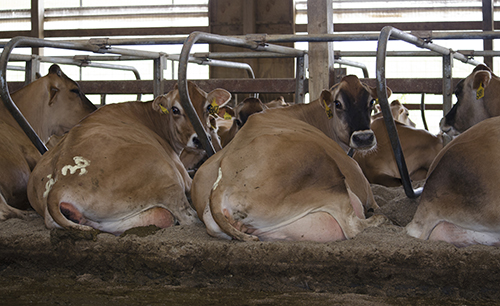
The climatic conditions encountered in many regions of the country necessitate cattle housing. Such strategies must therefore account for a means to reduce the mammary gland's exposure to environmental pathogens and minimize bacterial growth in cows' surroundings.
"Populations of bacteria in bedding are related to the number of bacteria on teat ends and rates of clinical mastitis," says Joe Hogan with The Ohio State University. Therefore, reducing the number of bacteria in bedding generally results in a reduction in environmental mastitis.
Ideally, bedding should be a low-moisture, inorganic material that contains few nutrients for bacteria to utilize. Washed sand is most commonly recommended for controlling environmental mastitis, as its low nutritive value limits pathogen growth.
Sand reclaimed from manure can be used as bedding if the organic load and moisture are comparable to washed sand. However, reclaiming and recycling sand from manure often leads to a higher organic content and greater exposure to mastitis pathogens, notes Hogan.
Bedding choice is often driven by the availability of inexpensive plant by-products that are common to a region. Many organic materials, such as sawdust or straw, contain very few mastitis pathogens before use in stalls. Yet, these organic materials provide adequate nutrition for pathogen populations to exceed 10 billion colony forming units per gram of bedding, often within 24 hours of its addition to stalls. This rapid growth often precludes bedding's soiled appearance.
The use of organic bedding material in stalls will influence the amount and type of pathogens in the environment, adds Hogan. Sawdust commonly contains expansive coliform populations, with rates of clinical mastitis caused by Klebsiella species highly correlated with Klebsiella counts in beddings. Manure solids have similar qualities to sawdust.
Straw bedding generally contains fewer coliforms, but streptococcal counts in straw generally exceed that of sawdust. Chopped newspaper contains similar bacterial counts to those in chopped straw.
With anaerobic digesters and additional competition for plant byproducts, the use of recycled manure solids has become more common. Bacterial populations in recycled manure are relatively low after storage but rise rapidly when used as bedding. The processing involved in anaerobic digestion does not render manure solids sterile or alter the environment of manure sufficiently to prevent the growth of mastitis pathogens.
Bedding's particle size also impacts the bacterial contamination of the environment. Finely chopped material supports greater bacterial numbers than the same bedding with larger particle sizes. Finer materials adhere more readily to teat skin, as well, heightening the exposure of the teat end to mastitis pathogens.

The author, Amanda Smith, was an associate editor and is an animal science graduate of Cornell University. Smith covers feeding, milk quality and heads up the World Dairy Expo Supplement. She grew up on a Medina, N.Y., dairy, and interned at a 1,700-cow western New York dairy, a large New York calf and heifer farm, and studied in New Zealand for one semester.








